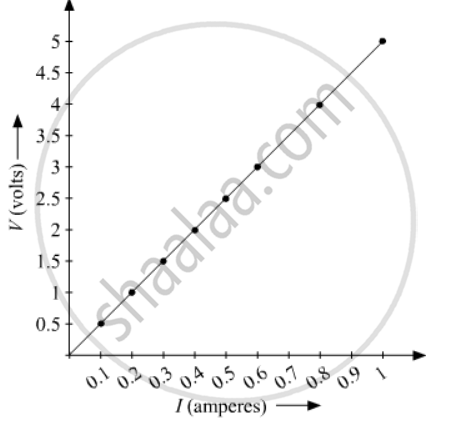Advertisements
Advertisements
Question
The values of current (I) flowing through a given resistor of resistance (R), for the corresponding values of potential difference (V) across the resistor are as given below:
| V (volts) | 0.5 | 1.0 | 1.5 | 2.0 | 2.5 | 3.0 | 4.0 | 5.0 |
| I (amperes) | 0.1 | 0.2 | 0.3 | 0.4 | 0.5 | 0.6 | 0.8 | 1.0 |
Plot a graph between current (I) and potential difference (V) and determine the resistance (R) of the resistor.
Solution
The plot between current (I) and potential difference (V) is given as,

Resistance of the resistor = Slope of the above graph
Chose two points A and B on the graph,

Slope of the graph is = Slope of line AB = `(4-1)/(0.8-0.2) = 3/0.6` = 5 Ω
APPEARS IN
RELATED QUESTIONS
Potential difference is measured in _________ by using a ___________ placed in ___________ across a component.
What do you understand by the term "electric potential"? (or potential) at a point? What is the unit of electric potential?
What is Ohm's law? Explain how it is used to define the unit of resistance.
Define the unit of resistance (or Define the unit "ohm").
If the potential difference between the end of a wire of fixed resistance is doubled, by how much does the electric power increase?
How does the resistance of a metallic wire depend on its temperature? Explain with reason.
Define the term ‘volt’.
Suppose there are three resistors A, B, and C having resistances r1, r2, and r3 respectively. If R represents their equivalent resistance, establish the following relation `1/"R" = 1/"r"_1 + 1/"r"_2 + 1/"r"_3`, when joined in parallel.
A current of 1 ampere flows in a series circuit containing an electric lamp and a conductor of 5 Ω when connected to a 10 V battery. Calculate the resistance of the electric lamp.
Now if a resistance of 10 Ω is connected in parallel with this series combination, what change (if any) in current flowing through 5 Ω conductor and potential difference across the lamp will take place? Give reason.
Name the instrument which is used to measure the potential difference.
